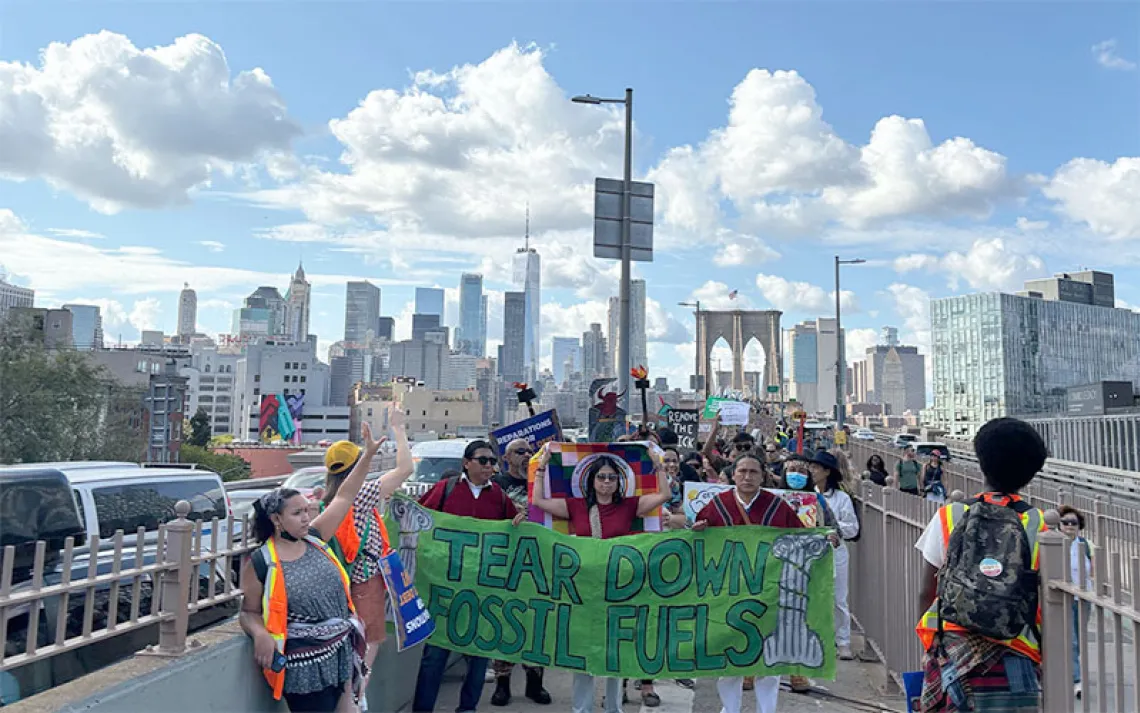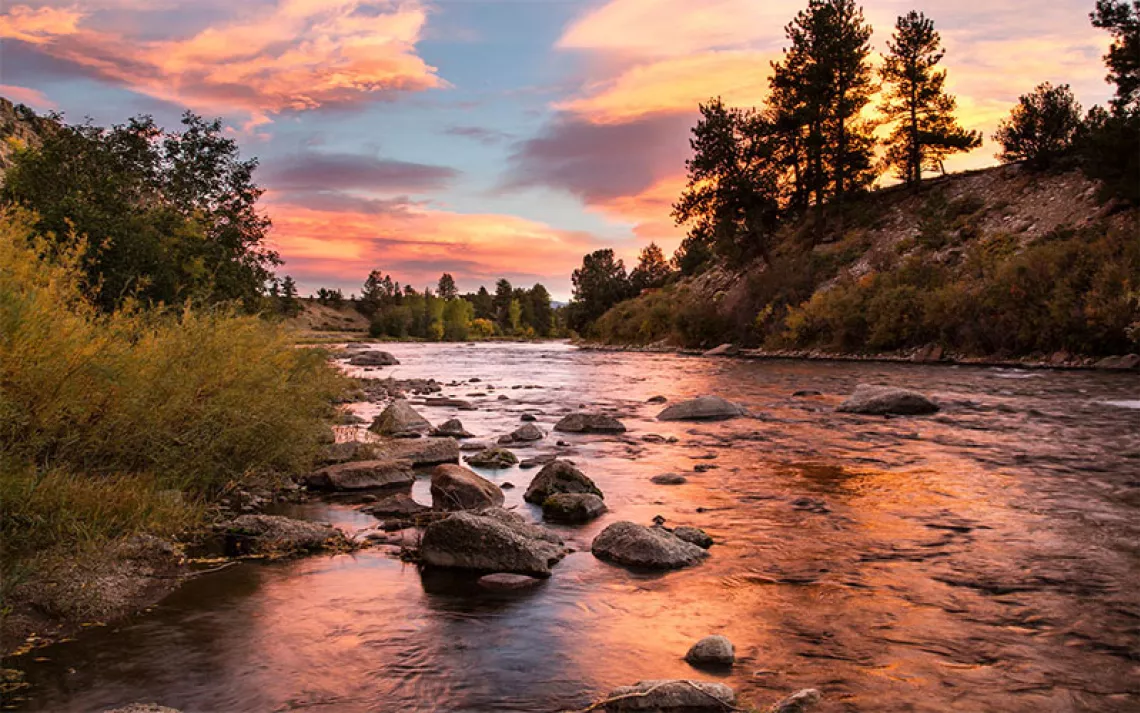A Letter From the Yankton Sioux Territory
A Native community suffers massive flooding, far from the eye of the media

Photos by Jacqueline Keeler
On Tuesday, October 8, members of the media were held in rapt attention as Greta Thunberg, the Swedish climate change activist, visited the tribal lands of the Standing Rock Sioux, the Native American nation that three years ago spearheaded a historic campaign against the Dakota Access oil pipeline.
“The #FridaysForFuture movement stand [sic] in solidarity with your struggles and hardships,” the climate strike teenager announced in a tweet the day before, during a visit to the Pine Ridge Reservation in South Dakota, “and the struggles of all Indigenous peoples in protecting their land, water, and traditions.”
Thunberg’s expression of solidarity for the struggles of Indigenous peoples was no doubt heartfelt. Before visiting Pine Ridge and Standing Rock, Thunberg had rallied with youths in Iowa City, Iowa. On her way between Iowa and Pine Ridge, she drove right drove past the Yankton Sioux reservation, where the community of Lake Andes has been struggling to stay above water since a “bomb cyclone” hit the region in March. If Thunberg had wanted to see firsthand “the struggles of all Indigenous peoples,” she could have stopped at Lake Andes, where she could have born witness to the neglect still endured by so many Native American communities.
I visited the Yankton Sioux reservation in early October, and even I—a Native person used to seeing how Indigenous communities are poorly treated—was shocked by what I saw there.
Hundreds of Native children have spent the past six months living in homes flooded by water. The main road to town, Highway 18, just reopened in September. Then, just two weeks after the reopening, another epic storm brought 11 inches of rain in 24 hours. The new road washed out, and homes once again flooded. Residents now rely on a much longer and rutted dirt road to get to town and school. During heavy rains, runoff also makes that road impassable.
"Our community is literally drowning," the tribe declared in an August 12 statement released even before the latest spout of rains, "due to State negligence and indifference to the health and well-being of our people." But state and federal officials have offered little to no help. There’s a National Guard unit based on the reservation, just 20 miles away in the town of Wagner, where the tribal offices are located. Tribal members say the Wagner National Guard unit has extensive bridge-building and water-treatment equipment to deal specifically with water disasters, and a trip from Wagner to Lake Andes usually takes just 15 minutes. But when the tribe asked Governor Kristi Noem to mobilize the guard, the South Dakota governor refused the tribe's request.
The Trump administration has also turned a blind eye to the humanitarian crisis on the Yankton Sioux reservation. After the most recent rains and flooding, the White House issued an emergency declaration for 25 counties in South Dakota, including the Cheyenne River Sioux Tribe and the Rosebud Sioux Tribe. The Yankton Sioux Tribe and the county that contains the reservation, Charles Mix County, were not included. Some Yankton tribal members speculate that the lack of action by both the state and federal governments may be due to their active support of Standing Rock Sioux during the Dakota Access Pipeline fight.
“It’s like we live in a third-world country and we are forgotten,” Lauren Crowe, a Yankton Sioux resident of Lake Andes, told me. “No one cares.”

If Thunberg had visited Lake Andes, she would have seen that the children living at the tribe's White Swan housing have skin ailments like ringworm and impetigo. The standing water in and around their homes has tested positive for E. coli. Local residents told me that one child has been treated for E. coli and another, a four-year-old, contracted MRSA, an antibiotic-resistant staph infection, at the hospital. Students from White Swan housing are being teased in school because, despite washing their clothes, other students can detect the smell of mold on them. In the past week, three families have made the difficult choice to abandon their homes because their children rely on nebulizers or have pneumonia and are having difficulty breathing.
On the Yankton Sioux reservation, the flooding of a home’s basement can be a major catastrophe. Many of the small homes are occupied by two to three generations, and before the flood the basements were used not only for storage but also as living quarters. As water seeped through the walls of the basements, furniture and beds were destroyed— a total loss for families who cannot afford to replace them. Since many families stored clothing in their basements, some children are now going to school without winter coats and boots.
As the black mold continues to grow in their homes, community volunteers suit up to clean the homes of elders or the disabled who cannot complete this task themselves. One resident returned home from the hospital after an organ transplant with his wife and seven kids to find black mold growing in the fridge.
Some residents are hesitant to turn on their basement furnaces, fearful they will release toxic mold spores into their homes. Yet winter has already descended upon the Great Plains. A snowstorm blanketed the western part of South Dakota earlier this month, and nighttime temperatures are now below freezing.
Since their homes smell of sewage, many Lake Andes residents prefer to eat meals together at the community center where neighbors volunteer to make meals three times a day. In the mornings, grandmothers gather early to drink their coffee together, unable to stand the smell of their homes.
But the community center, which also contains the gym and tribal police station, is a precarious refuge: It has flooded four times since March. Across the road is a sewage-treatment station, which has also been underwater and is now sandbagged. Tribal authorities watch it carefully; if it fails, sewage will back up and the entire community of 65 houses will have to be evacuated.
The ongoing flooding and displacement are, in a way, history repeating itself. The families that live in tribal housing at Lake Andes are mainly the descendants of the village of White Swan that once existed on the Missouri River. Like the town of Cannonball on the Standing Rock Reservation, it was flooded by the Army Corps of Engineers to build a hydroelectric dam in the 1950s. A series of dams were constructed under the Pick-Sloan Plan that selectively flooded and displaced Native American farmers and communities up and down the Missouri River. The Army Corps of Engineers later rebuilt Cannonball at Standing Rock. White Swan, however, was never rebuilt.
The Corps of Engineers did relocate the 19th-century, white clapboard Episcopal church of St. Philip the Deacon and hundreds of graves. But not all of the bodies were moved. In 1999, when water was lowered behind the Fort Randall dam, caskets and funeral objects were revealed to still be in place.
The water standing in the basements and pooling around the homes of Lake Andes likely also contains hazardous runoff from the intensive farming practices of the Native community’s white neighbors. The Yankton Sioux reservation is heavily "checkerboarded." That is, after the Dawes Allotment Act of 1887, land was allotted per tribal member, and any land "leftover" was opened up to homesteading. (Famously, one of those homesteading families was that of novelist Laura Ingalls Wilder, whose family resided on Dakota land). So in many places on the Great Plains, land ownership alternates from between tribal and nontribal.
Driving across southeastern South Dakota from Iowa and Nebraska, a visitor sees neat and tidy farms stretching to the horizon—seemingly the realized vision of Thomas Jefferson's dreamed-of agrarian republic. The price of this intensive farming of the formally wild prairie, however, is a poisoning of the lakes and groundwater with nitrates and phosphates from fertilizers and factory farms.
Lake Andes, once a popular resort destination, now experiences fish die-offs from algae blooms. Two winters ago, the lack of oxygen in the lake due to algae blooms killed many fish, which were then locked in winter ice—a haunting image that briefly took the Internet by storm.
Tribal members say they have been warned against allowing their dogs to swim in the lake water. Water from this same watershed is now filling people’s homes.
It’s too bad tribal leaders in Standing Rock did not look south to their relatives downriver on the Missouri and bring Thunberg to witness the suffering of Dakota children living in inundated houses.
During the epic battle against the Dakota Access Pipeline, the water protectors wore T-shirts and carried signs that said, “mni wiconi,” Lakota for “water is life.” While it’s true that water is life, it’s equally true that water can be death. America's policies of displacement and "development" of our Dakota and Lakota homelands have turned water into a death sentence for our communities. As the Yankton Sioux tribal leaders put it, “we are literally drowning.”
This article has been updated since publication.
 The Magazine of The Sierra Club
The Magazine of The Sierra Club



